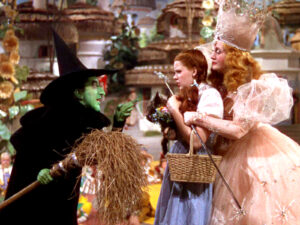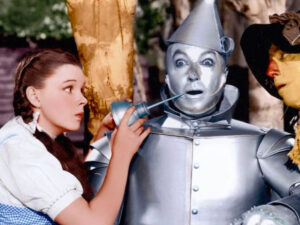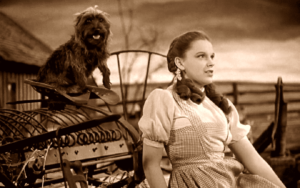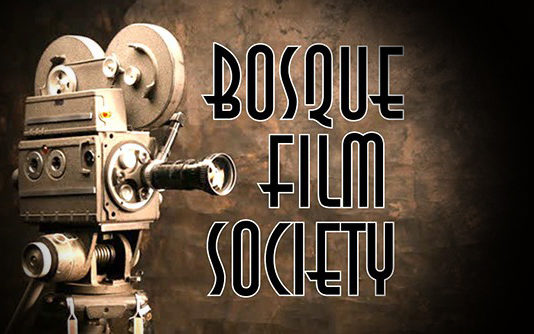Relive the most seen film in movie history on the silver screen with the presentation of the beloved 1939 musical fantasy “The Wizard of Oz” at The Cliftex Theatre
By BRYAN DAVIS
Bosque Film Society Historian & Founding Board Member
“Toto, I’ve got a feeling we’re not in Kansas anymore.” An audience of all ages discovered the magical land the tornado took Dorothy and Toto in being treated to the experience when the Bosque Film Society presented the beloved 1939 musical fantasy “THE WIZARD OF OZ” as the April showing of its monthly members-only Film Appreciation Night series April 11 at The Cliftex Theatre.
I was happy to have the opportunity to introduce one of my all-time favorite films that night. Make no mistake, there are a lot of movies I love, and I don’t even like musicals, or fantasy films, or science fiction even. But I love The Wizard of Oz, and I always have.
 It’s my first movie memory and my association of the power of film. It’s the movie that made me fall in love with film. It’s a movie I never tire of watching. It’s a movie that has become a generational classic. The first movie I wanted to share with my kids. And if I have grandkids, it’s the movie I’d want to share with them. And you probably feel the same way or you wouldn’t be here tonight, because Lord knows we’ve all seen it a hundred times.
It’s my first movie memory and my association of the power of film. It’s the movie that made me fall in love with film. It’s a movie I never tire of watching. It’s a movie that has become a generational classic. The first movie I wanted to share with my kids. And if I have grandkids, it’s the movie I’d want to share with them. And you probably feel the same way or you wouldn’t be here tonight, because Lord knows we’ve all seen it a hundred times.
So why is it so special? The Wizard of Oz isn’t for everyone. There are those who don’t like the movie. But they aren’t here tonight. Technically, it may not be perfect, but it’s pretty darn close. One film historian said the Munchkin Land sequence – from the time the house lands in black and white until Dorothy takes her first steps in glorious Technicolor down the Yellow Brick Road – stands out as perhaps the most magical 15 minutes ever filmed. Oscar-winning director Joel Cohn said “every director wants to direct The Wizard of Oz.” By that, he means a beloved film that stands the test of time. An extensive study in Italy of more than 25,000 films from around the world named Oz the most influential movie ever made.
Oz, the version we know and love, was the 10th time the classic L. Frank Baum series had been brought to the screen. It was released in 1939 – 84 years ago. And today, it’s even more famous than ever. It never falls from any of the Top 10 Lists of Greatest Films. The Library of Congress ranks Oz as the most-watched film in history. Rotten Tomatoes has given it the highest rating of any film. And it remains, without a doubt, the most beloved movie of all time.
It’s been translated into every language, seen in every country around the world, still casting the same magical spell on children of all ages. In other words, its appeal is universal and timeless. We all know the story, so I won’t spend any time talking about that. I’ll merely share a few interesting facts about the magic that is The Wonderful Wizard of Oz.
 The Cast
The Cast
Would The Wizard of Oz be so special of not for the flukes in casting that ended up as the film we know?
Judy Garland’s Dorothy is the glue that holds this film together and makes is timeless. Can you imagine any other Dorothy? Judy Garland was considered too old, too big, and with a voice too worldly to play the innocent farm girl written as a nine-year-old. Instead, MGM wanted the biggest child star of all time to play Dorothy – Shirley Temple. But 20th Century Fox refused to release their box office champ to competitor MGM and the role went to Judy.
But the filming was tough for the 16-year-old girl with the big voice. To look younger, her breasts were bound and to keep her weight down she was given diet pills and everything she ate was monitored. She was given pills to help her sleep at night and pills to wake her in the morning for the long film shoots. Director Victor Fleming once slapped Garland across the face to get her attention.
 Although it would seem inconceivable today, Billie Burke, who played Glinda the Good Witch, was the most recognizable actor in the film in 1939. Burk was 54, a star of silent films and the wife of Florence Ziegfeld of the Ziegfeld Follies, one of the most famous showmen and producers of all time. Burke had the largest, most beautiful dressing room on the MGM lot.
Although it would seem inconceivable today, Billie Burke, who played Glinda the Good Witch, was the most recognizable actor in the film in 1939. Burk was 54, a star of silent films and the wife of Florence Ziegfeld of the Ziegfeld Follies, one of the most famous showmen and producers of all time. Burke had the largest, most beautiful dressing room on the MGM lot.
Several turned down the title role of The Wizard before it finally landed in the lap of contract player Frank Morgan. He was second-billed in the film, an Oscar nominee and a prestigious addition to the classic movie. W.C. Fields was actually signed to play the part, but argued over money, billing and demands that he stay sober, ultimately withdrawing from the film. Morgan, by the way, plays six roles in the film. In addition to The Wizard, he plays Professor Marvel, the gatekeeper at the Emerald City, the coachman of the carriage drawn by “The Horse of a Different Color,” the Emerald City guard at the door, and the Wizard’s scary face projection.
The role of the Wicked Witch was originally given to beautiful Oscar winning actress Gayle Sondergaard. But after filming began, the director felt the Witch should more menacing, not beautiful. So the role fell to an unknown contract player named Margaret Hamilton.
Hamilton ends up with less than five minutes of screen time as the Witch after much of her performance was cut from the film. But she leaves such an impact that she seems ever-present in the movie and has been named the fourth best screen villain of all time by the American Film Institute, behind Darth Vader, Hannibal Lector, and Norman Bates from Psycho.
Another aside, Hamilton was nearly killed during one of her first scenes in the film. Watch for her during the exit in Munchkin Land. It was rehearsed for her to step onto an elevator that would drop her beneath the floor to leave in a puff of smoke and 40-foot fireball. But when the cameras rolled the flames were released too early and Hamilton’s costume, hat, broom, and facial prosthetics caught fire. She suffered severe burns to her face, arms, and upper body, was hospitalized for weeks and off the film even longer. If you notice, the accident was left in the finished film. When she returned, she said they could find another witch, “but no more fire for this old gal.”
 Originally, Ray Bolger was originally cast as the Tin Man and Buddy Ebsen as the Scarecrow. But Bolger wanted to play the Scarecrow so badly that he and Ebsen were allowed to switch roles. This was unfortunate, because Ebsen developed an allergic reaction to the lead in the makeup that nearly killed him and required his role to be recast by vaudeville actor Jack Haley. But Ebsen would go on to even bigger television fame as Jed Clampett in “The Beverly Hillbillies” television series as well as “Barnaby Jones.”
Originally, Ray Bolger was originally cast as the Tin Man and Buddy Ebsen as the Scarecrow. But Bolger wanted to play the Scarecrow so badly that he and Ebsen were allowed to switch roles. This was unfortunate, because Ebsen developed an allergic reaction to the lead in the makeup that nearly killed him and required his role to be recast by vaudeville actor Jack Haley. But Ebsen would go on to even bigger television fame as Jed Clampett in “The Beverly Hillbillies” television series as well as “Barnaby Jones.”
The last principal actor cast in the film was Bert Lahr, who was so memorable as the Cowardly Lion. His costume was excruciating, however, weighing more than 60 pounds and made from the skin of a real lion. The grueling eight-month Technicolor filming required such bright lighting that temperatures hovered near 100 degrees. The makeup for Dorothy’s three sidekicks were so detailed they were not allowed to remove costumes, forced to eat through straws during the day and rest on slanted board between scenes.
There were 124 little people cast as the Munchkins and the flying monkeys. Most were part of a vaudeville act, The Singer’s Midgets. Entire books have been written about the little people from Oz. The last surviving cast member from the film was Munchkin Jerry Maren, who played one of the Lollypop Guild, who died in 2018.
 One of the hardest parts to cast was the part of Dorothy’s constant canine sidekick, Toto. Toto was played by a female Cairn terrier named Terry, owned and trained by Carl Spitz. She was six-years-old and already a seasoned pro with several films to her credit, including “Bright Eyes” with Shirley Temple. She was paid $125 a week, which was more than many actors in the film, including the Munchkins.
One of the hardest parts to cast was the part of Dorothy’s constant canine sidekick, Toto. Toto was played by a female Cairn terrier named Terry, owned and trained by Carl Spitz. She was six-years-old and already a seasoned pro with several films to her credit, including “Bright Eyes” with Shirley Temple. She was paid $125 a week, which was more than many actors in the film, including the Munchkins.
Terry the Cairn terrier was seriously injured when one of the Witch’s guards stepped on her foot and broke it. She missed two weeks of filming and had become so attached to Judy Garland that her owner allowed her to recuperate at home with Garland. Terry legally took the name of Toto in 1943. After her death, she was buried on the Spitz ranch, which is now covered by the Ventura Freeway.
Behind the Scenes
Historically, 1939 has been called the best single year of filmmaking. Besides Oz, 1939 also produced Stagecoach, Wuthering Heights, Goodbye Mr. Chips, and the biggest bonanza of them all, Gone With the Wind. And not only were GWTW and Oz both from 1939 and two of the most important films ever made, they both are credited to the same director, Victor Fleming. But actually, four directors worked on Oz, with Fleming being yanked off the film to take over the troubled Gone With the Wind from George Cukor.
Several of the most brilliant directors of the day lent their special touches to Oz, most notably King Vidor who directed the black and white Kansas sequences including “Over the Rainbow.” The first director, Richard Thorpe, was fired after two weeks, but he did make the Wicked Witch scary instead beautiful and changed Dorothy from a blond to a brunet farm girl.
But it was Fleming who received sole directing credit, and he took home the Oscar for best director of 1939, not for Oz, for Gone With the Wind. And, he is the only director to have directed two films considered among the best ten movies of all time.
 Something else to consider…the transition from the drab, sepia-toned reality of Kansas to the full-blown Technicolor excess of Oz was brilliant and shocking to audiences of the day. The special effects were state-of-the art, and Oscar nominated. Take the tornado scene, developed 70 years before CGI… it is still more frightening and realistic than much of what is found today, and was accomplished with a nylon stocking and miniature sets. And the costumes, more than 1,000 for an estimated 600 actors, took the MGM costume department months to create.
Something else to consider…the transition from the drab, sepia-toned reality of Kansas to the full-blown Technicolor excess of Oz was brilliant and shocking to audiences of the day. The special effects were state-of-the art, and Oscar nominated. Take the tornado scene, developed 70 years before CGI… it is still more frightening and realistic than much of what is found today, and was accomplished with a nylon stocking and miniature sets. And the costumes, more than 1,000 for an estimated 600 actors, took the MGM costume department months to create.
And speaking of costumes. Several items from Oz are among the most coveted of movie memorabilia. Two of Dorothy’s blue and white gingham dresses survived, and one sold for $1.56 million in 2021. There were seven pairs of ruby slippers, often called the “Holy Grail of Hollywood,” but two were destroyed and one was stolen. Each of the four surviving pair are valued at more than $2 million dollars. Interestingly enough, the costume worn by Bert Lahr as the Cowardly Lion sold for $3.1 million dollars in 2014.
The Legacy
The Wizard of Oz received six Oscar nominations, including best picture. Someone I spoke with last week told me the music is what they loved most from the film. And it was the music that stopped Gone With the Wind from almost having a clean sweep of the 1939 Oscars. The music and lyrics were by Harold Arlen and E.Y. Harburg. While they collaborated on all the tunes, they won the Oscar for Best Song for “Over the Rainbow.”
The second Oscar won for the film was Best Original Score, which went to composer Herbert Stothart for his sweeping score and orchestration. Judy Garland was presented a special Oscar for her performance, which was occasionally done for young performers in those days.
The film was a moderate success, but didn’t break even until its re-release in 1949. The legend that is The Wizard of Oz didn’t begin until the annual television broadcast began in 1956, playing annually through the late 1970s.
 Hard to believe, but “Over the Rainbow” almost didn’t end up in the final cut of the movie, because producers wanted 30 minutes trimmed to keep Oz less than two hours. They also believed it wasn’t dignified for Garland, who the studio was grooming as their next big star, to be singing to a dog in the barnyard. The song was ultimately saved, won the Oscar, and has been covered by more artists than any song other than “Yesterday” by the Beatles. After 84 years, it still tops every legitimate songwriting and film list as the best movie song of all time.
Hard to believe, but “Over the Rainbow” almost didn’t end up in the final cut of the movie, because producers wanted 30 minutes trimmed to keep Oz less than two hours. They also believed it wasn’t dignified for Garland, who the studio was grooming as their next big star, to be singing to a dog in the barnyard. The song was ultimately saved, won the Oscar, and has been covered by more artists than any song other than “Yesterday” by the Beatles. After 84 years, it still tops every legitimate songwriting and film list as the best movie song of all time.
By the way, other scenes cut to shorten the film were a beautiful dance number by the scarecrow and a song and dance sequence intended to appeal to teens called “The Jitterbug.” And, much of Margaret Hamilton’s work as the Wicked Witch, which was so intense it terrified children during screenings.
In 1988, the Library of Congress established the National Film Preservation Board to preserve films deemed “culturally, historically, or esthetically important.” “The Wizard of Oz” was included in those first 25 landmark films to be included in 1989.
The film has had a huge influence on all of pop culture and on everyday life. People are always quoting lines from the film. In fact, three of them are included in the AFI’s 100 best movie lines of all time.
No. 99 – “I’ll get you my pretty, and your little dog, too.”
No. 23 – “There’s no place like home.”
No. 4 – “Toto, I’ve got a feeling we’re not in Kansas anymore.”
I had never seen The Wizard of Oz on the big screen before. What a pleasure it was to watch the movie The American Film Institute calls the Sixth Greatest American Movie ever made — the 1939 MGM classic, The Wizard of Oz – on the historic silver screen at The Cliftex Theatre.

